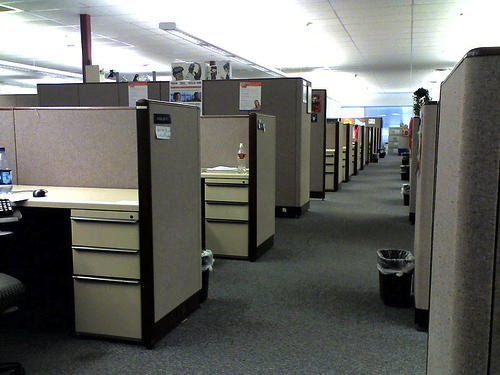
Section Branding
Header Content
WORKING: It Matters Where You Sit
Primary Content

Some companies are starting to micromanage who sits where in the office—to the level of putting specific workers next to each other and separating people who work in the same department.
Some of these businesses also change up the seating arrangements every few months. The idea is to foster creativity and encourage innovative thinking.
"If I change the [organizational] chart and you stay in the same seat, it doesn't have very much of an effect," Ben Waber told the Wall Street Journal. He is chief executive of Sociometric Solutions, a Boston company that uses sensors to analyze communication patterns in the workplace. "If I keep the org chart the same but change where you sit, it is going to massively change everything."
Workplace culture expert Brandon Smith said such approaches have their benefits. They can, he said, encourage workers to expand their network of colleagues and learn more about what other people do. But do they lead to innovation?
“I would argue only if that’s being driven from above,” said Smith, who teaches about communication, leadership and workplace culture at Emory University and Georgia State University. “If you just mix people together and cross your fingers and hope innovative, creative stuff comes out of that without setting those expectations, it’s just not going to happen.”
Plus, Smith said, you can risk alienating workers put off by all the moving.
“I’m a fan of having a home base, a space I can come back to to do my work,” he said. “This would drive me nuts. That little bit of anxiety I would feel every time I got moved would have me not focusing on my work and focusing more on that discomfort [of moving].”
Still, organizations can use these rearrangements to improve employees’ attitudes or disposition. Waber told the Journal 40 percent to 60 percent of a worker’s interactions through the day are with the people who sit at the next desk or office. And the attitudes of those workers can be contagious.
“It requires a little more thought around social engineering,” Smith said.
Researchers at the University of Pennsylvania’s Wharton School found the most-contagious emotional state is one that’s calm, laid-back and relaxed. That can be helpful, Smith said.
“You want to put that relaxed person with a high-stress group to calm them down,” he said, noting managers also have to be careful not to move an anxious, high-stress person around and spread their anxiety throughout the organization.
“There are some benefits to this, but our big takeaway is, it requires some thoughtfulness, some planning,” Smith said. “And gauge your organization. If you decide to take this on, gauge your group. See if they like it. Keep polling them.”
Brandon Smith teaches about leadership, communication, and workplace culture at Emory University's Goizueta Business School. More of his advice is on his blog and at theworkplacetherapist.com. While you’re there, ask him your workplace or career question. We might answer you in a future radio segment.
Tags: career counseling, Brandon Smith, workplace, working, career, office seating
